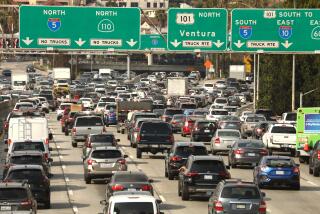High-Tech Devices Steer Drivers to Distraction
- Share via
SACRAMENTO — Gone are the good old days of distracted driving when motorists merely juggled coffee, shaved, read a map, drove with a pet dog in the lap and lighted cigarettes for the miles still ahead.
Today, millions of American drivers are taking traditional driver absent-mindedness to new heights.
Behind the wheel, they’re talking on cellular phones, sending and receiving pages, checking sports scores on personal digital assistants and even sneaking a glance or two at television.
Although the much-maligned cell phone gets the headlines for stealing drivers’ “glance time” and causing abrupt lane weaving, experts say it’s the mere tip of the iceberg.
In California, a state that has long defined American car culture, more commute-weary residents are loading up their interiors with VCR and DVD players, fax machines and dashboard video screens for satellite navigation systems.
Experts attribute the trend to the state’s legendary and worsening traffic, which traps people in their cars for longer stretches and further blurs lines between the office and front seat.
And that is raising new fears among an array of authorities from lawmakers to insurance companies of a spate of new road crashes as more people are literally driven to distraction.
Nationally, officials believe that up to 30% of crashes are caused by driver distractions that include mobile communications devices.
A March report by the National Conference of State Legislatures suggests that device-related distractions that killed an estimated 600 to 1,000 motorists in 2001 could kill 2,000 a year by 2004.
The report also cites “great potential” for even more dramatic increases in fatalities by the decade’s end.
To those who spend most of their lives on the roads, the handwriting is on the asphalt.
“We see it all the time,” said Leo Williams, a North Carolina trucker who watches passengers and drivers play video games, hold phones to their ears and work laptop computers.
At an I-80 truck stop east of San Francisco, New Mexico trucker Gene Smith added: “Computers. They’re going down the road with a computer on in the front seat. I see more of that.”
“You can now buy aftermarket TVs and plug them into the dash and actually watch DVD movies,” said Lt. Joel Broumas, who heads the traffic division at the Modesto Police Department in the Central Valley. “We stopped a kid who was driving a nice Blazer. He had one hooked up in the dash, about an eight-or nine-inch deal.”
Academics have coined the word “carcooning” to describe how people increasingly outfit their cars for comfort, entertainment and productivity. Phone systems are built in. New stereos pull in satellite radio broadcasts and play MP3 files downloaded from the Internet.
“We’re seeing a lot of requests for mobile video,” said Doug Kalpakoff, salesman at Wireless World in Morgan Hill, Calif. “Fewer people are flying and more are driving. The most popular is the drop-down screen from the roof. We see that in larger SUVs.”
Some stores, he says, now install video screens on front-seat passenger visors. That’s already alarmed some California legislators, who proposed bills this year and last to follow the lead of New York state and ban drivers from using hand-held cell phones.
Both measures died after vigorous opposition by major wireless companies, which argued that the number of wireless phone users jumped from 10 million in 1988 to 120 million in 2002 without a huge corresponding increase in car crashes.
Already, cell phones, in-car electronics and radio-CD systems represent the leading cause of inattention in crashes that killed 6,516 Californians and injured 413,913 last year.
Those causes ran well ahead of eating, smoking, children, pets, reading and personal hygiene. But many, including the California Highway Patrol, which last year joined 15 states that gather such statistics, believe that cell phone and high-tech inattention is greatly underreported because most offenders don’t admit to it.
Auto industry spokesmen say consumers drive the demand for devices that often distract them, and carmakers also oppose limiting “what you can put in your car.”
But Vann Wilber, director of vehicle safety for the Washington, D.C.-based Alliance of Automobile Manufacturers, says that “it’s not a particularly precise science” between what overloads one driver and doesn’t distract another. “It’s kind of a new frontier in the study of human factors and human engineering.”
On California’s I-80, Williams and Smith grouse heartily about “the lady in the van, on the phone, smoking a cigarette, drinking coffee, fixing her hair and taking the kids to school.” But Williams also confesses to a cell phone habit, saying, “I can’t say anything. I have one myself.”
Smith also shows what’s on his front seat. “They give me my load assignments on this,” he said.
It’s a laptop computer.






